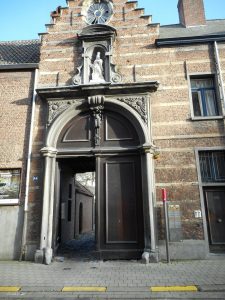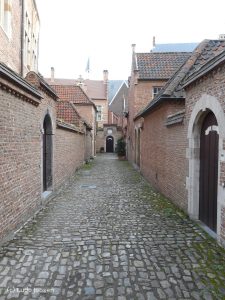A quiet spot in the middle of town: the Antwerp beguinage

A beguine is a woman who lives together with fellow sisters inside a beguinage, a little secluded from the world. Like a nun she has vowed to obey the convent’s head-mistress (grootjoffer), to live a life of poverty and chastity . Unlike a nun she can always leave the community she is living in.
History
The first beguines appeared around the era of the crusades. The many wars in Europe and the crusades themselves had resulted in a surplus of women. For many of them it had become impossible to find a suitable mate. Moreover very often they could not raise the dowry to enter a classical convent. So they started forming groups of women who lived together and performed chores to earn their living.
Among these chores were laundry work, nursing, teaching, lacework and the like. At first the Church authorities regarded them with some mistrust. They feared it might result in a new form of heresy, but gradually the Church accepted these half-nuns. Usually a monk, mainly franciscan or dominican, looked after them and guided them in their religious life.

In the twentieth century the number of beguines dropped drastically. Nowadays there are no beguines anymore. At least not in our region. In some German towns like Hamburg e.g. a new beguinage arose, although the religious aspect is not always as important as it used to. These present day beguines do not live in a hierarchically ordered society either.
Spread
Almost every town in the Netherlands used to have a beguinage. Some cities had more than one. In its heydays a beguinage could count 150 to 160 beguines which was a bit difficult to manage. So very often they founded a new one.
In 1998 13 Flemish beguinages were placed on the UNESCO World Heritage List. Unfortunately the Antwerp one wasn’t. The Antwerp beguinage used to border the city walls. In World War II the area suffered tremendously from bombings and in the 1960’s blocks of flats were built. The backsides of these blocks now befoul the view from the beguinage.
Still: the beguinage with its interior garden is an oasis in the otherwise busy environment of the students’ quarter. The center of the Antwerp University and the Ossenmarkt with its many bars, lie just around the corner. If you go there, respect the quiet of the place, please.
More information on Flemish beguinages can be found here.


